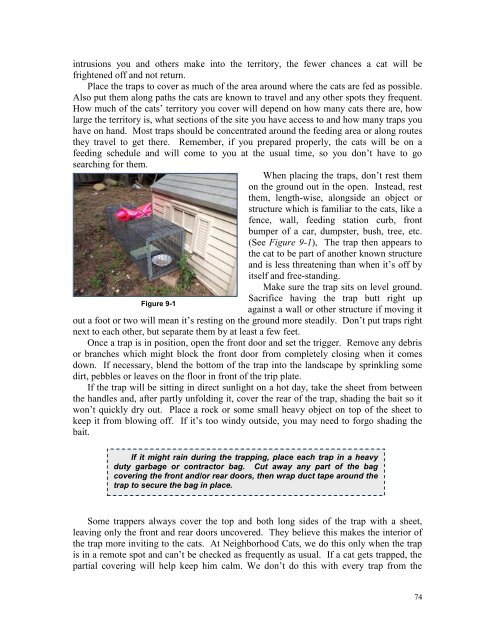download/print - Neighborhood Cats
download/print - Neighborhood Cats
download/print - Neighborhood Cats
- No tags were found...
Create successful ePaper yourself
Turn your PDF publications into a flip-book with our unique Google optimized e-Paper software.
intrusions you and others make into the territory, the fewer chances a cat will befrightened off and not return.Place the traps to cover as much of the area around where the cats are fed as possible.Also put them along paths the cats are known to travel and any other spots they frequent.How much of the cats’ territory you cover will depend on how many cats there are, howlarge the territory is, what sections of the site you have access to and how many traps youhave on hand. Most traps should be concentrated around the feeding area or along routesthey travel to get there. Remember, if you prepared properly, the cats will be on afeeding schedule and will come to you at the usual time, so you don’t have to gosearching for them.When placing the traps, don’t rest themon the ground out in the open. Instead, restthem, length-wise, alongside an object orstructure which is familiar to the cats, like afence, wall, feeding station curb, frontbumper of a car, dumpster, bush, tree, etc.(See Figure 9-1), The trap then appears tothe cat to be part of another known structureand is less threatening than when it’s off byitself and free-standing.Make sure the trap sits on level ground.Figure 9-1Sacrifice having the trap butt right upagainst a wall or other structure if moving itout a foot or two will mean it’s resting on the ground more steadily. Don’t put traps rightnext to each other, but separate them by at least a few feet.Once a trap is in position, open the front door and set the trigger. Remove any debrisor branches which might block the front door from completely closing when it comesdown. If necessary, blend the bottom of the trap into the landscape by sprinkling somedirt, pebbles or leaves on the floor in front of the trip plate.If the trap will be sitting in direct sunlight on a hot day, take the sheet from betweenthe handles and, after partly unfolding it, cover the rear of the trap, shading the bait so itwon’t quickly dry out. Place a rock or some small heavy object on top of the sheet tokeep it from blowing off. If it’s too windy outside, you may need to forgo shading thebait.If it might rain during the trapping, place each trap in a heavyduty garbage or contractor bag. Cut away any part of the bagcovering the front and/or rear doors, then wrap duct tape around thetrap to secure the bag in place.Some trappers always cover the top and both long sides of the trap with a sheet,leaving only the front and rear doors uncovered. They believe this makes the interior ofthe trap more inviting to the cats. At <strong>Neighborhood</strong> <strong>Cats</strong>, we do this only when the trapis in a remote spot and can’t be checked as frequently as usual. If a cat gets trapped, thepartial covering will help keep him calm. We don’t do this with every trap from the74








